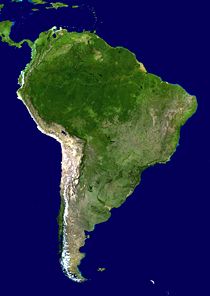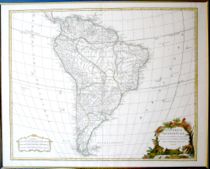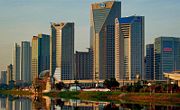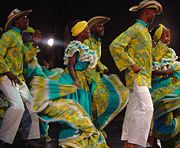South America
2008/9 Schools Wikipedia Selection. Related subjects: Central & South American Geography
South America
| Area | 17,840,000 km² |
|---|---|
| Population | 382,000,000 |
| Countries | 12 |
| Dependencies | 3 |
| Demonym | South American |
| Languages | Spanish, Portuguese, French, Dutch, English, Quechua, Aymara, Guaraní, etc |
| Time Zones | UTC -2:00 (Brazil) to UTC -5:00 (Ecuador) |
| Largest Cities | São Paulo Buenos Aires Rio de Janeiro Bogotá Lima Santiago Caracas |
South America is a continent occupying the southern part of the supercontinent of America. It sits entirely in the Western Hemisphere, and mostly in the Southern Hemisphere with a small portion in the Northern Hemisphere. It is bordered on the west by the Pacific Ocean and on the north and east by the Atlantic Ocean. North America and the Caribbean Sea lie to the northwest.
South America was named in 1507 by cartographers Martin Waldseemüller and Matthias Ringmann after Amerigo Vespucci, who was the first European to suggest that the Americas were not the East Indies, but a New World unknown to Europeans.
South America has an area of 17,840,000 square kilometers (6,890,000 sq mi), or almost 3.5% of the Earth's surface. As of 2005, its population was estimated at more than 371,090,000. South America ranks fourth in area (after Asia, Africa, and North America) and fifth in population (after Asia, Africa, Europe, and North America).
Geography
South America occupies the major southern portion of the landmass generally referred to as the New World, the Western Hemisphere, the Americas, or simply America (which is sometimes considered a single continent and South America a subcontinent). It is south and east of the Colombia-Panama border according to most authorities or, according to a few, the Panama Canal which transects the Isthmus of Panama. Almost all of mainland South America sits on the South American Plate. Geopolitically and geographically, all of Panama – including the segment east of the Panama Canal in the isthmus – is generally considered a part of North America alone and among the countries of Central America.
Many of the islands of the Caribbean (or West Indies) – e.g., the Leeward and Lesser Antilles – sit atop the Caribbean Plate, a tectonic plate with a diffuse topography. The islands of Aruba, Barbados, Trinidad, and Tobago sit on the northerly South American continental shelf. The Netherlands Antilles and the federal dependencies of Venezuela lie along the northerly South American. Geopolitically, the island states and overseas territories of the Caribbean are generally grouped as a part or subregion of North America. The South American nations that border the Caribbean Sea – including Colombia, Venezuela, Guyana, Suriname, and French Guiana – are also known as Caribbean South America. Other islands are the Galápagos, Easter Island (in Oceania but belongs to Chile), Robinson Crusoe Island, Chiloé, and the Tierra del Fuego.

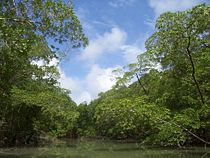
South America is home to the world's highest waterfall, Angel Falls in Venezuela, the largest river (by volume), the Amazon River, the longest mountain range, the Andes (whose highest mountain is Aconcagua at 6,962 m (22,841 ft)), the driest desert, the Atacama Desert, the largest rainforest, the Amazon Rainforest, the highest capital city, La Paz, Bolivia, the highest commercially navigable lake in the world, Lake Titicaca, and the world's southernmost town, Puerto Toro, Chile.
South America's major mineral resources are gold, silver, copper, iron ore, tin, and oil. The many resources of South America have brought high income to its countries especially in times of war or of rapid economic growth by industrialized countries elsewhere. However, the concentration in producing one major export commodity often has hindered the development of diversified economies. The inevitable fluctuation in the price of commodities in the international markets has led historically to major highs and lows in the economies of South American states, often also causing extreme political instability. This is leading to efforts to diversify their production to drive them away from staying as economies dedicated to one major export.
South America is home to many interesting and unique species of animals including the llama, anaconda, piranha, jaguar, vicuña, and tapir. The Amazon rainforests possess high biodiversity, containing a major proportion of the Earth's species.
The largest country in South America by far, in both area and population, is Brazil, followed by Argentina. Regions in South America include the Andean States, the Guianas, the Southern Cone, and Brazil.
History
The rise of agriculture and domestication of animals
South America is thought to have been first inhabited by people crossing the Bering Land Bridge, which is now the Bering Strait. Some archaeological finds do not fit this theory, and have led to an alternative theory Pre-Siberian American Aborigines. The first evidence for the existence of agricultural practices in South America date back to circa 6500 BC, when potatoes, chillies and beans began to be cultivated for food in the highlands of the Amazon Basin. Pottery evidence further suggests that manioc, which remains a staple foodstuff today, was being cultivated as early as 2000 BC.
By 2000 BC many agrarian village communities had been settled throughout the Andes and the surrounding religious regions. Fishing became a widespread practice along the coast which helped to establish fish as a primary source of food. Irrigation systems were also developed at this time, which aided in the rise of an agrarian society.
South Americans cultures began domesticating llamas, vicuñas, guanacos, and alpacas in the highlands of the Andes circa 3500 BC. Besides their use as sources of meat, and wool, these animals were used for transportation of goods (maximum load for a llama is typically 40 kg).
Pre-Colombian civilizations
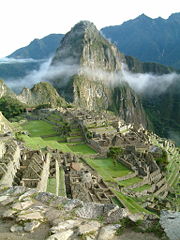
The rise of agriculture and the subsequent appearance of permanent human settlements allowed for the multiple and overlapping beginnings of civilizations in South America.
The earliest known settlements, and culture in South America, and the Americas altogether, are the Valdivia on the south east coast of Ecuador.
The earliest known South American civilization was at Norte Chico, on the central Peruvian coast. Though a pre-ceramic culture, the monumental architecture of Norte Chico is contemporaneous with the pyramids of Ancient Egypt. The Chavín established a trade network and developed agriculture by 900 BC, according to some estimates and archaeological finds. Artifacts were found at a site called Chavín de Huantar in modern Peru at an elevation of 3,177 meters. Chavín civilization spanned 900 BC to 300 BC.
The Muisca were the main indigenous civilization in what is now modern Colombia. They established a confederation of many clans, or cacicazgos, that had a free trade network among themselves. They were goldsmiths and farmers.
Other important Pre-Columbian cultures include: Moche (100 BC – 700 AD, at the northern coast of Peru); Tiuahuanaco or Tiwanaku (100 BC – 1200 AD, Bolivia); the Cañaris (in south central Ecuador), Paracas and Nazca (400 BC – 800 AD, Peru); Wari or Huari Empire (600 – 1200, Central and northern Peru); Chimu Empire (1300 – 1470, Peruvian northern coast); Chachapoyas; and the Aymaran kingdoms (1000 – 1450, Bolivia and southern Peru).
Holding their capital at the great cougar-shaped city of Cusco, the Inca civilization dominated the Andes region from 1438 to 1533. Known as Tawantin suyu, or "the land of the four regions," in Quechua, the Inca civilization was highly distinct and developed. Inca rule extended to nearly a hundred linguistic or ethnic communities, some 9 to 14 million people connected by a 25,000 kilometer road system. Cities were built with precise, unmatched stonework, constructed over many levels of mountain terrain. Terrace farming was a useful form of agriculture. There is evidence of excellent metalwork and even successful brain surgery in Inca civilization.
European colonization
In 1494, Portugal and Spain, the two great maritime powers of that time, on the expectation of new lands being discovered in the west, signed the Treaty of Tordesillas, by which they agreed that all the land outside Europe should be an exclusive duopoly between the two countries.
The Treaty established an imaginary line along a north-south meridian 370 leagues west of Cape Verde Islands, roughly 46° 37' W. In terms of the treaty, all land to the west of the line known to comprehend most of the South American soil), would belong to Spain, and all land to the east, to Portugal. As accurate measurements of longitude were impossible at that time, the line was not strictly enforced, resulting in a Portuguese expansion of Brazil across the meridian.
Beginning in the 1530s, the people and natural resources of South America were repeatedly exploited by foreign conquistadors, first from Spain and later from Portugal. These competing colonial nations claimed the land and resources as their own and divided it into colonies.
European infectious diseases (smallpox, influenza, measles, and typhus) to which the native populations had no immune resistance, and systems of forced labor, such as the haciendas and mining industry's mita, decimated the native population under Spanish control.
African slaves were brought in large quantities for several centuries for a number of reasons, both political and economical; however, it was mainly because they were much better fitted than the American natives for hard labor in tropical climate such as sugar cane plantations or gold mining.
The Spaniards were committed to convert their native subjects to Christianity and were quick to purge any native cultural practices that hindered this end; however, most initial attempts at this were only partially successful, as native groups simply blended Catholicism with traditional idolatry and their polytheistic beliefs. Furthermore, the Spaniards did impose their language to the degree they did their religion, although the Roman Catholic Church's evangelization in Quechua, Aymara, and Guaraní actually contributed to the continuous use of these native languages albeit only in the oral form.
Eventually, the natives and the Spaniards interbred, forming a mestizo class. Essentially all of the mestizos of the Andean region were offspring of Amerindian mothers and Spanish fathers. Mestizos and the Indian natives were often forced to pay extraordinary taxes to the Spanish crown and were punished more harshly for disobeying the law.
Many native artworks were considered pagan idols and destroyed by Spanish explorers; this included many gold and silver sculptures and other artifacts found in South America, which were melted down before their transport to Spain or Portugal.
Guyana was a Portuguese, Dutch, and eventually a British colony. The country was once partitioned into three, each being controlled by one of the colonial powers until the country was finally taken over fully by the British.
Independence
The South American possessions of the Spanish Crown won their independence between 1804 and 1824 in the South American Wars of Independence. Simón Bolívar of Venezuela and José de San Martín of Argentina were the most important leaders of the independence struggles. Bolívar led a great uprising in northern South America, then led his army southward towards the capital of the Viceroyalty of Peru, Lima. Meanwhile, San Martín led an army from the Viceroyalty of Rio de la Plata across the Andes Mountains, meeting up with General Bernardo O'Higgins in Chile, and then marched northward to gain the military support of various rebels from the Viceroyalty of Peru. The two armies finally met in Guayaquil, Ecuador, where they cornered the Royal Army of the Spanish Crown and forced its surrender.
In Brazil, a Portuguese colony, Dom Pedro I (also Pedro IV of Portugal), son of the Portuguese king Dom João VI, proclaimed the country's independence in 1822 and became Brazil's first Emperor. This was peacefully accepted by the crown in Portugal.
Although Bolivar attempted to unify politically the Spanish-speaking parts of the continent into the " Gran Colombia", they rapidly became independent states without political connections between them, despite some later attempts such as the Peruvian-Bolivian Confederation.
A few countries did not gain independence until the 20th century:
- Guyana, from the United Kingdom, in 1966
- Suriname, from Dutch control, in 1975
French Guiana remains part of France as of 2008, and hosts the European Space Agency's principal spaceport, the Guiana Space Centre.
Recent history
The continent became a battlefield of the Cold War in the late 20th century. Some governments of Argentina, Brazil, Chile, and Uruguay were overthrown or displaced by U.S.-aligned military dictatorships in the 1960s and 1970s. To curtail opposition, their governments detained tens of thousands of political prisoners, many of whom were tortured and/or killed (on inter-state collaboration, see Operation Condor). Economically, they began a transition to neoliberal economic policies. They placed their own actions within the U.S. Cold War doctrine of "National Security" against internal subversion. Throughout the 1980s and 1990s, Peru suffered from an internal conflict (see Túpac Amaru Revolutionary Movement and Shining Path). Colombia currently faces an internal conflict, often described as a civil war, which started in 1964 with the creation of Marxist guerrillas (FARC-EP) and now involves several illegal armed groups of both leftist and rightist leanings as well as the private armies of powerful drug lords and the Colombian state itself. Revolutionary movements and right-wing military dictatorships became common after World War II, but since the 1980s a wave of democratization came through the continent, and democratic rule is widespread now.
Nonetheless, allegations of corruption are still very common and several countries have developed crises which have forced the resignation of their governments, although, in most occasions, regular civilian succession has continued this far.
International indebtedness turned into a severe problem in late 1980s, and some countries, despite having strong democracies, have not yet developed political institutions capable of handling such crises without recurring to unorthodox economical policies, as most recently illustrated by Argentina's default in the early 21st century.
During the first decade of the 21st century, South American governments have drifted to the political left, with social democratic leaders being elected in Chile, Uruguay, Brazil, and left-populist presidents in Argentina, Ecuador, Nicaragua, Bolivia and Venezuela. In the late 2000s, the nations of South America banded together to constitute a supranational union intended to integrate South American economies and cultures, and potentially militaries, laws, and political structures, named the Union of South American Nations.
Regions
The countries in the table below are categorised according to the scheme for geographic regions and subregions used by the United Nations, and data included are per sources in cross-referenced articles. Where they differ, provisos are clearly indicated.
| Country or territory with flag |
Area (km²)(per sq mi) |
Population (July 2008 est.) |
Population density per km² |
Capital |
|---|---|---|---|---|
| |
2,766,890 km² (1,068,302 sq mi) | 40,677,348 | 14.3/km² (37/sq mi) | Buenos Aires |
| |
1,098,580 km² (424,164 sq mi) | 9,247,816 | 8.1/km² (21/sq mi) | La Paz, Sucre |
| |
8,514,877 km² (3,287,612 sq mi) | 191,908,598 | 22.0/km² (57/sq mi) | Brasília |
| |
756,950 km² (292,260 sq mi) | 16,454,143 | 21.1/km² (54.6/sq mi) | Santiago |
| |
1,138,910 km² (439,736 sq mi) | 45,013,674 | 37.7/km² (97.6/sq mi) | Bogotá |
| |
283,560 km² (109,483 sq mi) | 13,927,650 | 47.1/km² (122/sq mi) | Quito |
| |
12,173 km² (4,700 sq mi) | 2,967 | 0.24/km² (0.6/sq mi) | Stanley |
| |
91,000 km² (35,135 sq mi) | 209,000 | 2.1/km² (5.4/sq mi) | Cayenne |
| |
214,970 km² (83,000 sq mi) | 770,794 | 3.6/km² (9.3/sq mi) | Georgetown |
| |
406,750 km² (157,047 sq mi) | 6,347,884 | 15.6/km² (40.4/sq mi) | Asunción |
| |
1,285,220 km² (496,226 sq mi) | 27,925,628 | 21.7/km² (56.2/sq mi) | Lima |
| South Sandwich Islands (UK) |
3,093 km² (1,194 sq mi) | 20 | 0/km² (0/sq mi) | Grytviken |
| |
163,270 km² (63,039 sq mi) | 438,144 | 2.7/km² (7/sq mi) | Paramaribo |
| |
176,220 km² (68,039 sq mi) | 3,477,778 | 19.4/km² (50.2/sq mi) | Montevideo |
| |
912,050 km² (352,144 sq mi) | 26,414,815 | 27.8/km² (72/sq mi) | Caracas |
| Total | 17,824,513 | 382,426,313 | 21.5/km² |
Economy
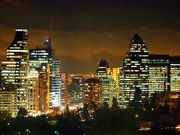
Due to histories of high inflation in nearly all South American countries, interest-rates and thus investment remain high and low, respectively. Interest rates are usually twice that of the United States. For example, interest-rates are about 22% in Venezuela and 23% in Suriname. The exception is Chile, which has been implementing free market economic policies since establishing military dictatorship in 1973 and increased its social spending since the return of democratic rule in the early 1990s. This has led to economic stability and interest rates in the low single digits.
The Union of South American Nations is a planned continent-wide free trade zone to unite two existing free-trade organizations – Mercosur and the Andean Community.
South America relies heavily on the exporting of goods and natural resources. On an exchange rate basis Brazil (the seventh largest economy in the world and the second largest in America) leads the way in total amount of exports at $137.8 billion dollars followed by Chile at 58.12 billion and Argentina with 46.46 billion.
The economic gap between the rich and poor in most South American nations is considered to be larger than in most other continents. In Venezuela, Paraguay, Bolivia and many other South American countries, the richest 20% may own over 60% of the nation's wealth, while the poorest 20% may own less than 5%. This wide gap can be seen in many large South American cities where makeshift shacks and slums lie adjacent to skyscrapers and upper-class luxury apartments.
| Country | GDP (nominal) of 2006 | GDP (PPP) of 2005 | GDP (PPP) per capita of 2005 | HDI of 2007 |
|---|---|---|---|---|
| 214,058 | 419,600 | 11,076 | ▲ 0.869 | |
| 11,163 | 34,200 | 3,623 | ▲ 0.695 | |
| 1,312,962 | 1,585,100 | 8,606 | ▲ 0.800 | |
| 145,841 | 199,800 | 12,277 | ▲ 0.867 | |
| 135,836 | 264,000 | 6,314 | ▲ 0.791 | |
| 40,800 | 86,400 | 6,541 | ▲ 0.772 | |
| 3,524 | N/A | 17,336 (nominal, 2006) | N/A | |
| 896 | 2,393 | 3,186 | ▲ 0.750 | |
| 9,110 | 23,000 | 3,905 | ▼ 0.755 | |
| 107,000 | 217,500 | 7,574 | ▲ 0.773 | |
| 1,597 | 2,591 | 5,770 | ▲ 0.774 | |
| 19,308 | 30,700 | 9,277 | ▲ 0.852 | |
| 181,862 | 262,800 | 9,888 | ▲ 0.792 |
Culture and language
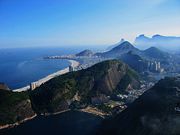
Portuguese and Spanish are the most spoken languages in South America, each spoken by around 90% of the continent's population. Portuguese is the official language of Brazil, which holds nearly 50% of the South American population. Spanish is the official language of most countries of the continent. Dutch is the official language of Suriname; English is the official language of Guyana, although there are at least twelve other languages spoken in the country such as Hindi, Arabic, and various indigenous dialects. English is also spoken in the Falkland Islands. French is the official language of French Guiana.
Indigenous languages of South America include Quechua in Ecuador, Peru, and Bolivia; Guaraní in Paraguay and, to a much less extent, in Bolivia; Aymara in Bolivia, Peru, and less often in Chile; and Mapudungun is spoken in certain pockets of southern Chile and, more rarely, Argentina. At least three South American indigenous languages ( Quechua in Ecuador, Peru, and Bolivia - Aymara also in Bolivia - and Guarani in Paraguay) are recognized along with Spanish as national languages.
Other languages found in South America include Hindi and Indonesian in Suriname; Italian in Argentina, Brazil, Uruguay, Venezuela, and Chile; and German in certain pockets of Argentina, Chile, Venezuela and Paraguay. German is also spoken in many regions of the southern states of Brazil, Riograndenser Hunsrückisch being the most widely spoken German dialect in the country; among other Germanic dialects, a Brazilian form of Pomeranian is also well represented and is experiencing a revival. Welsh remains spoken and written in the historic towns of Trelew and Rawson in the Argentinean Patagonia. There are also small clusters of Japanese-speakers in Brazil, Bolivia, Colombia, Paraguay, Peru, and Ecuador. Arabic speakers, often of Lebanese, Syrian, or Palestinian descent, can be found in Arab communities in Brazil, Ecuador, Peru, Chile, Argentina, and less frequently in Colombia and Paraguay.
In most of the continent's countries, the upper classes and well-educated people regularly study English, French, German, or Italian. In those areas where tourism is a significant industry, English and some other European languages are often spoken. There are small Spanish speaking areas in Southernmost Brazil due to the proximity of Uruguay.
South Americans are culturally enriched by the historic connection with Europe, especially Spain and Portugal, and the impact of mass culture from the United States of America.
South American nations have a rich variety of music. Some of the most famous genres include cumbia from Colombia, samba and bossa nova from Brazil, and tango from Argentina and Uruguay. Also well known is the non-commercial folk genre Nueva Canción movement which was founded in Argentina and Chile and quickly spread to the rest of the Latin America. People on the Peruvian coast created the fine guitar and cajon duos or trios in the most mestizo (mixed) of South American rhythms such as the Marinera (from Lima), the Tondero (from Piura), the 19th century popular Creole Valse or Peruvian Valse, the soulful Arequipan Yaravi, and the early 20th century Paraguayan Guarania. In the late 20th century, Spanish rock emerged by young hipsters influenced by British pop and American rock in Argentina, Chile, Colombia, Peru, and Uruguay. Brazil has a Portuguese-language pop rock industry as well a great variety of other music genres.
The literature of South America has attracted considerable critical and popular acclaim, especially with the Latin American Boom of the 1960s and 1970s, and the rise of authors such as Gabriel García Márquez in novels, and Pablo Neruda and Jorge Luis Borges in other genres.
Because of South America's broad ethnic mix, South American cuisine takes on African, American Indian, Asian, and European influences. Bahia, Brazil, is especially well-known for its West African-influenced cuisine. Argentines, Chileans, and Uruguayans regularly consume wine while Argentina along with Paraguay, Uruguay, and people in southern Chile and Brazil enjoy a sip of mate a regional brewed herb cultivated for its drink, the paraguayan version, terere, differing from the others in that it's served cold. Pisco is a liquor distilled from grapevine produced in Peru and Chile; however, there is a recurring dispute between those countries regarding its origins. Peruvian cuisine mixes elements from Chinese, Japanese, Spanish, African, Andean, and Amazonic food.
Demographics
Descendents of Indigenous peoples, such as the Quechua and Aymara, make up the majority of the population in Bolivia and are a significant element in most other former Spanish colonies. Exceptions to this include Argentina, Brazil, and Uruguay where people of European descent make up the majority of the population. Mestizos (mixed white and Amerindian) are the largest ethnic group in Peru, Paraguay, Venezuela, Chile, Colombia, and Ecuador. African descendants are also a significant group in Brazil, Colombia, Venezuela and Ecuador. Suriname is the only country in South America where Asians form the majority of the population. Peru has the main Chinese community in Latin America and the second Japanese community (after Brazil).
Indigenous peoples
|
|
- Arawaks
- Wai Wai

